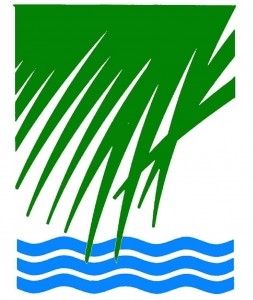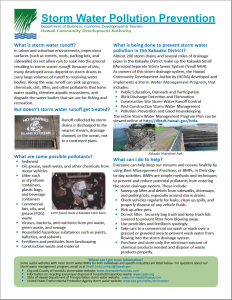Storm Water Pollution Prevention
Posted on Jun 24, 2019 in MainSTORM SEWER SYSTEM IN KAKA’AKO
HCDA owns a portion of the storm drain system in the Kaka’ako Community Development District and at the Kewalo Basin Harbor. Nearly 200 storm drains and several miles of drainage pipe make up HCDA’s Kaka’ako Small Municipal Separate Storm Sewer System (MS4) and HCDA is responsible under state law and the federal Clean Water Act to manage this storm drainage infrastructure system and comply with national pollutant discharge permit requirements.
Unlike clean water or treated wastewater systems, a storm sewer system is an untreated drainage system developed to allow large volumes of water to be conveyed during heavy rainfall. Storm drainage systems do not filter out pollutants from the collected runoff before discharging into our streams, harbors, and ocean. Therefore, HCDA practices several good housekeeping measures to prevent pollutants from comingling with our rainwater to help keep our state’s ocean safe and clean.
The Clean Water Act regulations & the NPDES permit
The Clean Water Act governs water pollution in the United States and establishes the regulatory framework for surface water quality as well as discharges of pollutants into the nation’s waters. Under the Clean Water Act, the United States Environmental Protection Agency (EPA) has implemented pollution control standards and developed the National Pollutant Discharge Elimination System (NPDES) permit program which aims to prevent water pollution by regulating, monitoring, and reporting discharges through a point source (such as an MS4) into a body of water.
In the State of Hawai’i, the EPA has authorized the Department of Health (DOH) Clean Water Branch to issue NPDES permits and both the EPA and the DOH continually enforce NPDES permit regulations. The Kaka’ako MS4 as owned by HCDA is covered by two general NPDES MS4 permits – one for the Kaka’ako Community Development District and the other for the Kewalo Basin Harbor. The NPDES MS4 permit requires HCDA to develop and implement a comprehensive Storm Water Management Plan (SWMP) for the development district and the harbor that includes pollution prevention measures, pollutant treatment or removal techniques, and measures to control the quality of the storm water discharged into our storm drain system.
STORM WATER MANAGEMENT PLAN
Water quality in our Kaka’ako MS4 is affected by a collection of storm runoff from lands controlled by HCDA, as well as the Department of Transportation-Highways, the City and County of Honolulu, and the University of Hawaii – John A. Burns School of Medicine. This flow of storm water runoff can pick up chemicals, sediments, particulates, pathogens from pet waste, trash, and other debris along the way which would degrade our water bodies and threaten aquatic ecosystems.
Our Storm Water Management Plan (SWMP) for the Kaka’ako Community Development District (KCDD) and for the Kewalo Basin Harbor (KBH) describes the Best Management Practices (BMP’s) that HCDA will implement to prevent land-based pollution and runoff from reaching our state waters. The SWMP covers six minimum control measures for pollution prevention:
- PUBLIC EDUCATION & OUTREACH
- PUBLIC PARTICIPATION/INVOLVEMENT
- ILLICIT DISCHARGE DETECTION & ELIMINIATION
- CONSTRUCTION SITE RUNOFF CONTROL
- POST-CONSTRUCTION RUNOFF CONTROL
- POLLUTION PREVENTION/GOOD HOUSEKEEPING
*2022 revisions to both KCDD and KBH SWMP’s are currently undergoing review by DOH.
Illicit Storm Water Discharge and How To Prevent – 2023 Annual Article
Rain Garden HCDA 2022 Annual Article
Storm Water Pollution Prevention Newsletter
Ocean Friendly Restaurants Article





